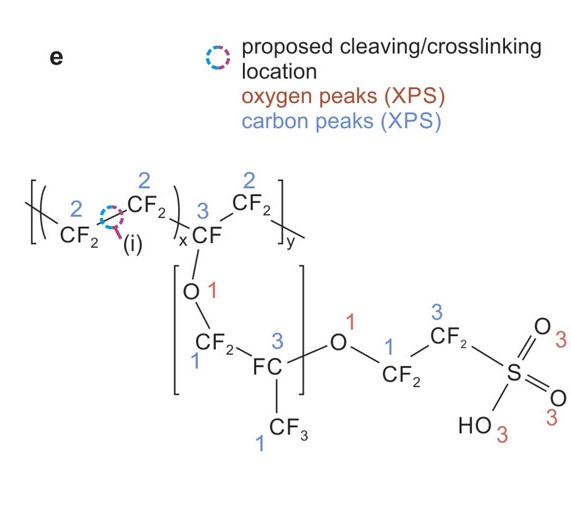 Nafion is a polymer first developed in the 1970s. Unlike the typical polymer long chain of hydrocarbons, its structure contains Fluorine atoms rather than hydrogens (making it perfluorinated), as well as acidic chemical components. Interestingly, it also has many nano-channels that can stretch. These structures provide the molecule with useful properties, specifically, excellent ionic conductivity and water absorbance. These properties make it especially useful for fuel cells or sensing applications. Some exciting technologies are also being developed using Nafion in neuromorphic computing - where a computer system is modelled on the human brain and nervous system and bioelectronics.
Nafion is a polymer first developed in the 1970s. Unlike the typical polymer long chain of hydrocarbons, its structure contains Fluorine atoms rather than hydrogens (making it perfluorinated), as well as acidic chemical components. Interestingly, it also has many nano-channels that can stretch. These structures provide the molecule with useful properties, specifically, excellent ionic conductivity and water absorbance. These properties make it especially useful for fuel cells or sensing applications. Some exciting technologies are also being developed using Nafion in neuromorphic computing - where a computer system is modelled on the human brain and nervous system and bioelectronics.
Recently a research group from Swansea University and the University of New South Wales, Australia, were able to use an electron beam to produce experimental patterned Nafion films across a large area, publishing their success in a paper which can be found here. However, the research raised questions about how the electron beam patterning process might be affecting the properties of the Nafion films.
.png)
In this study, the group uncovered that the electron beam patterning process changes the way water is absorbed in the film, with thick films showing a relative decrease. However, they also found that in thin films, the absorbance has a relative increase. The team used X-ray photoelectron spectroscopy, quartz crystal microbalance studies, impedance spectroscopy and neutron reflectometry (at both the ISIS Neutron and Muon source and ANSTO, Australia). Each technique revealed a different part of the puzzle, but in each case, they were able to compare “pristine” Nafion (untouched by an electron beam), to electron beam patterned Nafion.
During the ISIS experiment, the team studied a pristine form of Nafion on our INTER beamline (the results of which you can read here). They custom-built a vapour delivery system with valves that they could manually operate to increase the water content, allowing them to examine the ability of the sample to absorb water. This, in combination with further neutron reflectometry experiments on the Platypus beamline at ANSTO allowed them to compare the absorbance for both pristine and electron patterned Nafion.
The experiments were all split between thick films (of 230nm) and thin films (of 30nm) to work out if thickness played a part in any changes. The data showed that the water uptake in thick films is greatly reduced by electron patterning. The team suspect that this is because the electron beam causes crosslinks to form within the structure, which would restrict the water channels from expanding and so reduce their water uptake.
Studies on thin films show an entirely different effect, where the absorbance capacity is enhanced. However, it is thought that this is not due to any electron beam effects, but rather that the thickness itself allows this increase. In addition to this research, the team also investigated the ionic conductivity properties of the different Nafion films where they found that the electron beam does seem to reduce the film’s ionic conductivity. This could be problematic as that is the key property making Nafion so useful in computing and electronics. However, that reduction is less than an order of magnitude and so is potentially less impactful than the changes in water absorbency.
Overall, these results provide just a starting point in this area. We look forward to hearing about the further research that is needed to create a full picture of what is happening in this conundrum.
